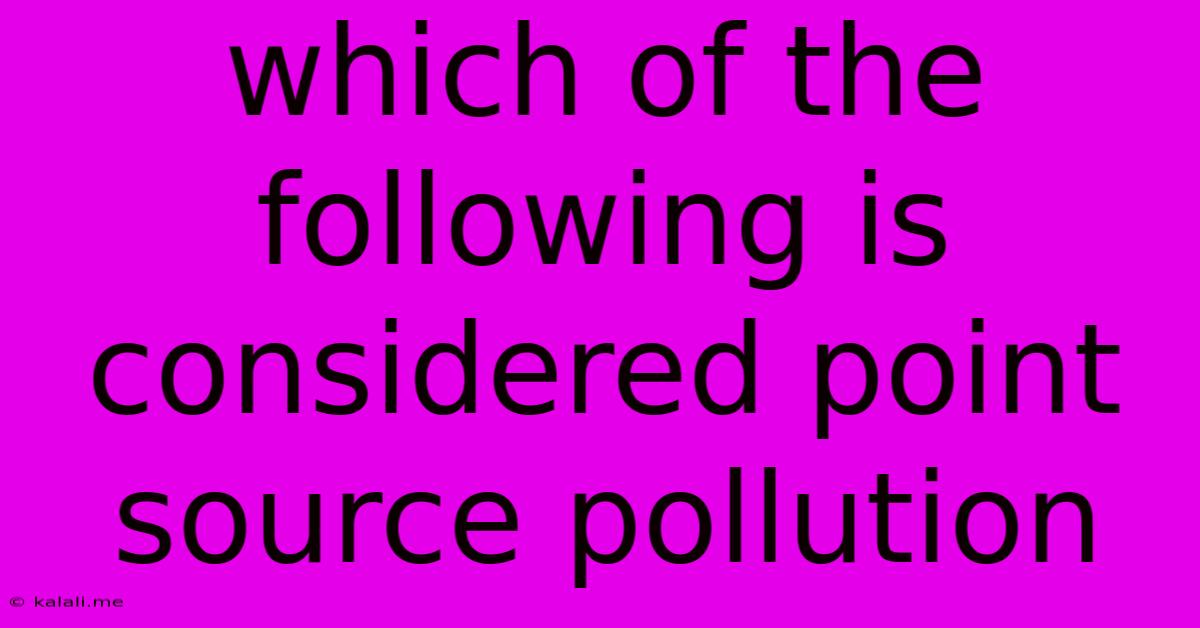Which Of The Following Is Considered Point Source Pollution
Kalali
Jun 14, 2025 · 3 min read

Table of Contents
Which of the Following is Considered Point Source Pollution? Understanding Pollution Sources
Point source pollution is a significant environmental concern, impacting water quality and ecosystems globally. Understanding what constitutes point source pollution is crucial for effective pollution control and mitigation strategies. This article will define point source pollution, differentiate it from non-point source pollution, and provide examples to clarify the concept.
What is Point Source Pollution?
Point source pollution refers to any single identifiable source of pollution from which pollutants are discharged. This contrasts sharply with non-point source pollution, which is discussed later. Think of it as pollution emanating from a specific, readily identifiable location. The key is that the pollution source is easily traceable and can be directly monitored and regulated. This makes controlling point source pollution easier than controlling non-point source pollution. Effective management often involves implementing specific permits and regulations on the discharge.
Examples of Point Source Pollution:
Several industries and activities contribute to point source pollution. Here are some key examples:
-
Industrial Discharges: Factories and manufacturing plants often release wastewater containing chemicals, heavy metals, and other pollutants directly into waterways through discharge pipes. This is a classic example of point source pollution. The specific pollutants discharged will vary drastically depending on the industry (e.g., textile mills, paper mills, chemical plants).
-
Municipal Wastewater Treatment Plants: While designed to treat wastewater, these plants can still discharge treated effluent containing residual pollutants into rivers, lakes, or oceans. Although treated, the effluent can still contain contaminants. The quality of the effluent is carefully monitored and regulated.
-
Stormwater Runoff from Industrial Sites: Even though stormwater runoff is generally considered a non-point source, runoff from industrial sites that collects and is discharged through a pipe or other conveyance system is considered a point source. This is because the discharge point is clearly defined.
-
Oil Spills from Tankers or Pipelines: These catastrophic events release massive amounts of oil into the environment, clearly originating from a specific point. The environmental impact of such spills can be devastating and long-lasting.
-
Underground Storage Tanks: Leaks from underground storage tanks holding gasoline, oil, or other hazardous materials can contaminate groundwater, representing a point source of pollution that can be difficult to detect and remediate.
Non-Point Source Pollution: A Key Distinction
It's crucial to understand the difference between point and non-point source pollution. Non-point source pollution comes from many diffuse sources, making it difficult to identify and regulate. Examples include agricultural runoff, urban stormwater runoff, and atmospheric deposition. These pollutants are dispersed over a wide area, making them harder to control.
Consequences of Point Source Pollution:
The consequences of point source pollution are severe and wide-ranging:
-
Water Quality Degradation: Pollutants contaminate water bodies, making them unsafe for drinking, recreation, and aquatic life. This can lead to eutrophication (excessive algae growth) and oxygen depletion, harming aquatic ecosystems.
-
Harm to Aquatic Life: Pollutants can directly poison aquatic organisms or indirectly impact them through habitat destruction and reduced food availability. This can cause population declines and biodiversity loss.
-
Human Health Risks: Contaminated water can lead to various health problems in humans, including waterborne diseases and long-term health issues from exposure to toxic chemicals.
-
Economic Impacts: Point source pollution can damage industries dependent on clean water, such as fishing and tourism. Cleanup costs can also be substantial.
Conclusion:
Point source pollution is a serious environmental problem that requires careful monitoring and regulation. By understanding what constitutes point source pollution and the associated consequences, we can develop and implement effective strategies to minimize its impact and protect our water resources. The examples provided highlight the diverse nature of point source pollution, emphasizing the importance of comprehensive environmental regulations and responsible industrial practices.
Latest Posts
Latest Posts
-
Why Do We Need A Constitution
Jun 14, 2025
-
Which Of The Following Statements Regarding Radioactive Decay Is True
Jun 14, 2025
-
All Of The Following Are Barriers To Effective Communication Except
Jun 14, 2025
-
Which Of The Following Is A Function Of Money
Jun 14, 2025
-
What Is The Difference Between A Square And A Rhombus
Jun 14, 2025
Related Post
Thank you for visiting our website which covers about Which Of The Following Is Considered Point Source Pollution . We hope the information provided has been useful to you. Feel free to contact us if you have any questions or need further assistance. See you next time and don't miss to bookmark.